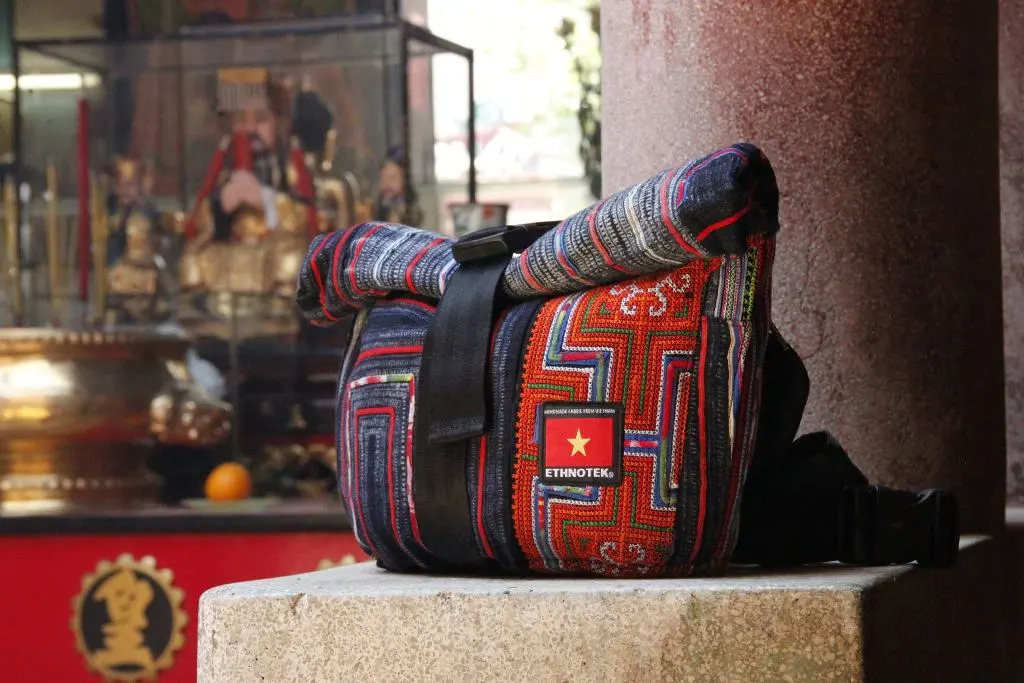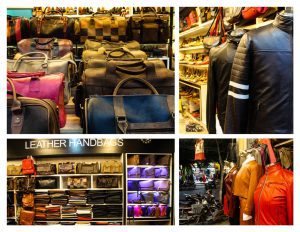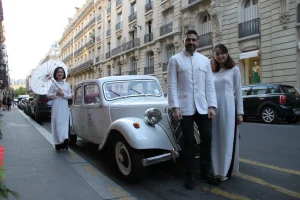Whether you live in Vietnam, or are simply traveling through, this country has a way of finding its way into your heart.
Artists and artisans alike have found inspiration in this diverse country of colors, cultures and scenery. Here are some of our favorite gifts inspired by Vietnam that anyone on your list would be thrilled to receive!
Notebooks, Bags and Travel Accessories via Viet Artisans

“We’re very proud of all our products. We never say: ‘Please buy because it’s charity’. We say: ‘Buy because you like what we’re doing, what we’re designing.’” So says Lily Pham of her stylish Vietnam-inspired notebooks, bags and travel accessories. Immigrating to the US at the age of 11, Lily founded Viet Artisans as a way to give something back to the country of her birth.
“I’ve seen my parents’ generation – very talented, creative people – but because of the war, they couldn’t make anything of themselves.
I don’t know if it’s a blessing or a curse, but I feel I owe Vietnam something. Until I do something, build something that can contribute towards its growth, I feel my life is incomplete.”

From that sentiment grew Viet Artisans, a social enterprise employing rural and disadvantaged women in Vinh Long at a craft center built on Lily’s grandmother’s land. Lily’s goal with Viet Artisans was job creation, giving people a way out, instead of merely providing charity. “In the Mekong Delta, typical jobs might be construction worker, fruit picker, doing odd jobs,” explains Lily.
“The worse thing about that is they are unable to plan for the future. Everything is a dream, not a plan. People might say things like: ‘I wish my kid could finish school’, but that’s still not a plan. If something unfortunate happens, people just have to accept it.
With us, they earn a decent salary, we pay for health insurance, some of their children receive scholarships, and they receive training,” Lily says of the 11 people employed by Viet Artisans who spend their days sewing, silk screening, making tote bags and binding notebooks.

Select Viet Artisan products are carried at Gingko, Artbook and the A O Show in Saigon. Their full range of products is available at www.vietartisans.org with free delivery to the Nikko, Novotel and other hotels in District 1, Ho Chi Minh City.
Saving Culture, One Thread at a Time via Ethnotek Bags

Trekking far off the beaten path amongst the solitude of the hills of Sapa in Vietnam’s north, bag designer Jake Orak found astounded by the craftsmanship of the Hmong villages he encountered. “Seeing tribes in their natural environment, just existing, was incredible,” says Jake.
“Some didn’t even use money, just trade. I witnessed thriving communities, people with their hands dyed blue from indigo, wearing their traditional dress… I felt incredibly privileged to experience this and I wanted everyone I knew to know about it, that something like this still exists on earth. I felt a sense of responsibility wash over me.”
In an effort to preserve the art of weaving, Jake started sourcing textiles in 2010 and launched Ethnotek in 2011. The company’s business model involves spending weeks with weaving families to gain their trust. “It’s a business-to-business relationship. It’s not a charity,” he says.
“These people don’t want handouts. They want you to buy the things they create. They don’t want to leave their home to get a job in a factory. They want to stay at home and work from home. That keeps the kids in the village and it passes on the knowledge.
” The time spent in the villages also allows Jake to work through a detailed protocol of finding out more about the artisan’s process, everything from whether the dyes used are natural or synthetic, where the cotton comes from, where the dye is disposed and what motifs mean.
He also needs to be sure villagers have an export license and are tech savvy, being able to use email, receive wire transfers and understand shipping methods. Respecting fair trade standards also means asking about working hours, where the artisans live and how far they have to commute (in the case of collective weaving centers).

Jake now sources textiles from Vietnam, Indonesia, Ghana, Guatemala and India. A small factory in Vietnam turns these fabrics into “threads”, interchangeable covers for backpacks and messenger bags, and a range of chic travel accessories (think travel wallets and iPad covers). His Vietnamese textiles are embroidered by Red Hmong, Black Hmong and Flower Hmong villages in northern Vietnam and on looms in the Cham communities near Phan Rang.

Ethnotek bags, backpacks and travel accessories are available at select locations around the world or via the Ethnotek site.
French Design, Vietnamese Craftsmanship via Leo Menswear

Arriving in Vietnam in 2013, French menswear designer Alice Lehoux noticed that there was a gap in the market for well-made yet reasonably priced menswear. “I thought that I’d like to make my own stuff, something really nice.
After all, I love seeing a guy really stylishly dressed.” With the help of flatmates, friends and new acquaintances, Alice launched her first collection last year, comprising of casual t-shirts and shorts and work-chic button-down shirts and fitted pants in a combination of linens and cottons.
Alice describes the Leo aesthetic as “chic, comfortable and basic.” But “basic isn’t negative,” she clarifies. “It’s a piece you can keep for a long time and can mix and match.”

Leo incorporates fabrics made in Vietnam and other Asian countries, and is sewn in Vietnam, all with a certain French flair. On any given day, Alice and her design team will scour the city’s cramped markets searching for the perfect fabric, trying to trace the textiles back to their local manufacturers.
“Researching fabric is like a game,” she says. “Sometimes it’s really hot and you’re really tired, but when you find [the perfect fabric], it’s like Christmas!”
For Alice, the French-Vietnamese pairing is a win-win for everyone involved. “The Vietnamese are very good at patternmaking, shaping and volume. I can show them what I want and technically, they’re very good. For me, the most important advantage is being here and working directly with the artisans, tailors and seamstresses.
I give them my style, they give me their craftsmanship. It’s a win-win!” Consumers also reap the benefits of sourcing local with no item in the Leo 2016 collection costing more than VND 1 million. Beautifully made pants come in at just VND 700,000, linen shirts are around VND 500,000 with scarves and other accessories even less.

The Leo aesthetic is known for being basic but daring, pairing bold, colorful prints with more traditionally-cut styles – perhaps a flash of color in a pocket lining or a bold pattern on an inside cuff. “The Leo man needs to be just a little daring,” says Alice with a smile.

The 2016 Leo Collection is currently available at Kokois (24 Thao Dien, D2) and at Leo’s Facebook page.
Vintage Lighting via Nobi

A coffee shop owner turned designer, Binh An has been designing lighting from salvaged materials for over a year now. With no background in art or design, Binh An started out by designing a lamp for a friend’s birthday. It was so well received that she and her friend, Hoai Thuc, turned her hobby into a small business.
Tucked away in District 3, Nobi Lighting shares space with a tailor shop to display her lamps made of salvaged wood, motorbike chains, discarded plumbing and more. “I spend a lot of time walking around flea markets looking for inspiration and things to base a new design on, but quite often I also get lucky when people throw things away, I can often see potential in the things other people see as broken,” says An.

Another feature of the lamps are the bulbs, recalling vintage bulbs of yesteryear. An also handpaints designs on some of the bulbs, ranging from flowers and inspirational quotes to custom designs for weddings and other occasions.

Most of the smaller lamps start at just USD 10 and are available at their store / workshop (425/16 Nguyen Dinh Chieu, D3, Saigon) or via the Nobi Lighting Facebook page.
Custom Shoes and Leather Accessories by Dominique Saint Paul

You’d be hard pressed to find a more unusual design story than successful banker turned shoe designer Dominic Price.
Born in Saigon and raised in India in his early years, Dominic has been obsessed with custom shoes for as long as he can remember. As a 25 year old, Dominic took his shoe designs to a shoe fair in London in search of a manufacturer, but the project failed to take off.
Disenchanted, the budding designer decided to follow in his father’s footsteps and took a job trading bonds in an investment bank, leading to a successful financial career as Managing Director for India and Sri Lanka at JP Morgan Chase Bank and as Chief Executive Officer of JP Morgan Vietnam.

It wasn’t until his 50th birthday that he decided to return to his first love – shoe designing, and opened up Dominique Saint Paul, specializing in high-end customized shoewear.
Customers start by choosing from any one of their 13 different but traditional styles of shoes, but then personalize the shoes by selecting color, patternation, using a combination of materials like leather and suede, in essence creating a one of a kind shoe.
While the leather is imported from Florence, the construction and finishing of these shoes is strictly done in Vietnam using traditional European methods. Some even feature a Vietnamese twist, like a Dong Son star motif, either in the broguing or as a mother of pearl inlay, or an actual pearl embedded in the lantern-like tassels.

While it’s too late to have a custom pair of shoes made for this year, Dominique Saint Pierre also has beautiful leather products like phone cases, business card holders, belts and other leather goods. Visit the store at 29 Dong Du, D1 or the website.
An Artist’s Brush with Vietnam via Bridget March

A trip around Vietnam and Cambodia was all it took for UK artist Bridget March to leave her houseboat and teaching job in England and settle down in Saigon.
“I just love the colors that the Vietnamese use in their homes. There’s a mix of beautiful periwinkle blue, almost like in Provence, with the ubiquitous pale yellow ochre and terra cotta,” says Bridget of her explorations around the city. “With the Chinese, you get these bold colors, lucky colors.”
With a background in 3-D design and 20 years’ experience as a freelance product designer, Bridget’s artwork is a marriage of mechanics and creativity, seen through the details in the rows of symmetrical tiles of Hoi An’s Japanese Bridge and the precise arrangement of holes in a simple basket of fish.

Since making Vietnam her home, Bridget has published two books, one on Sapa and one on Hoi An, illustrated with her own drawings and narrating her experiences there. For 2016, Bridget has created a calendar with her illustrations inspired by her travels around Vietnam.

The calendar (USD 16) can be shipped internationally or delivered free of charge in Saigon and is available at her website.











